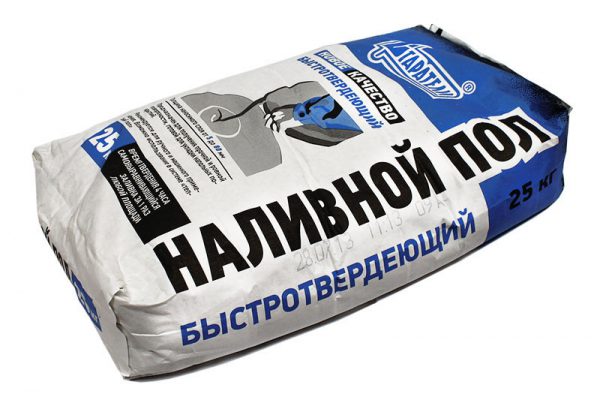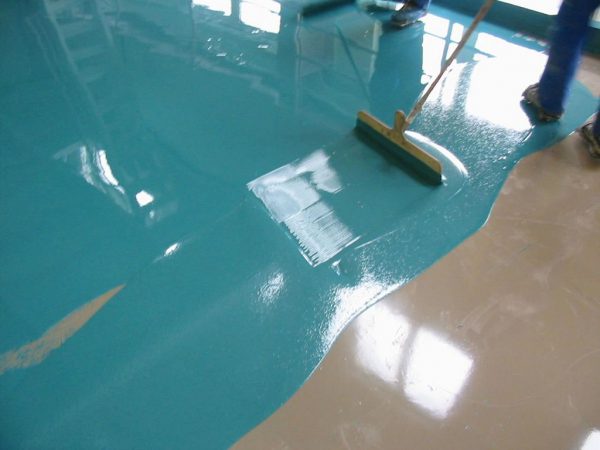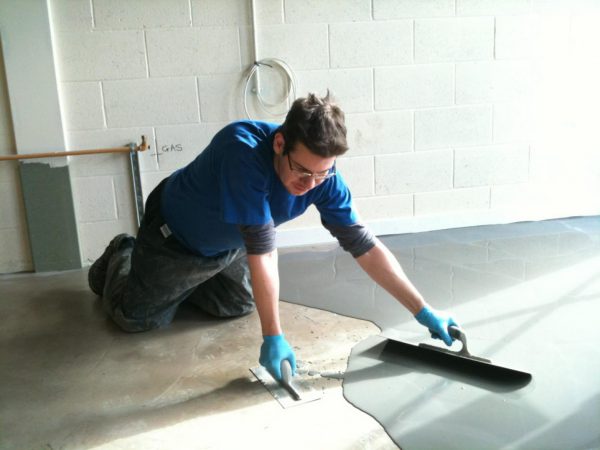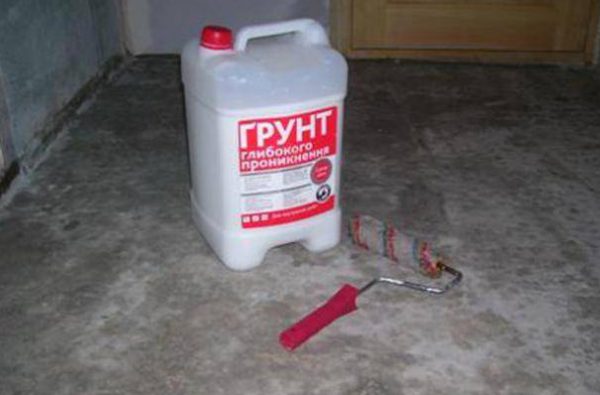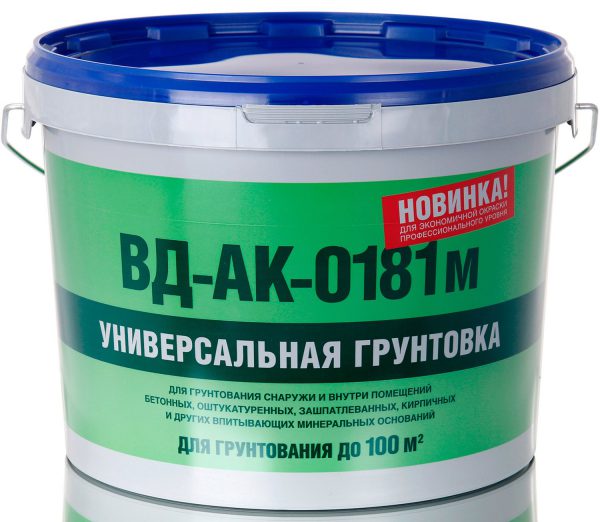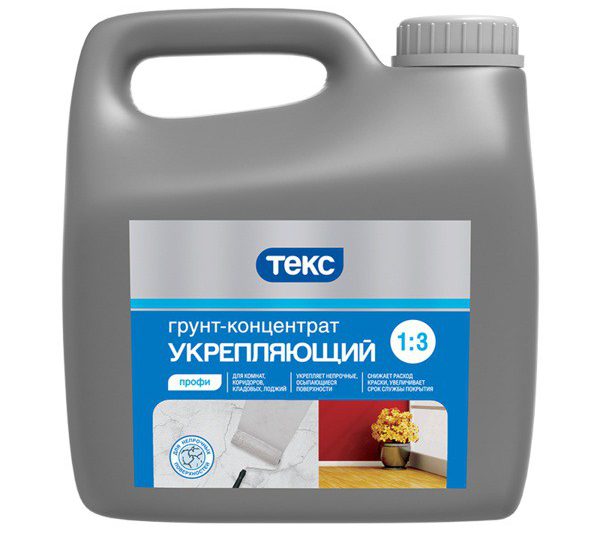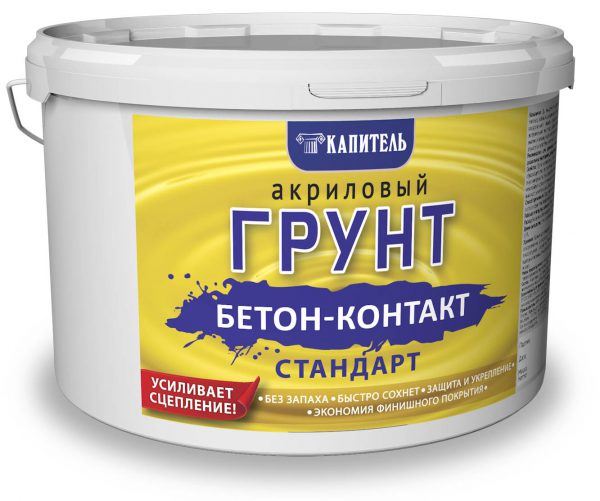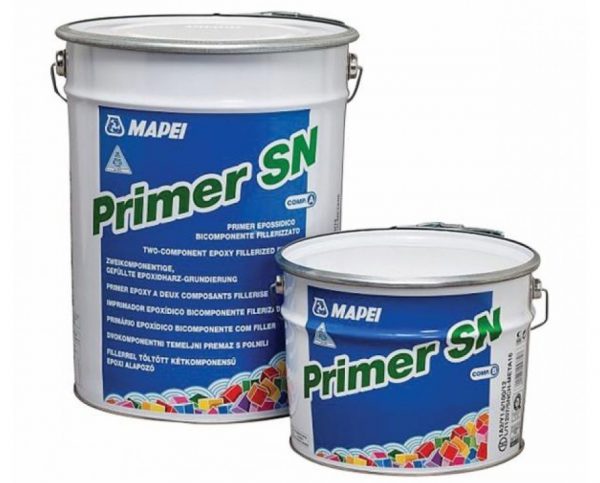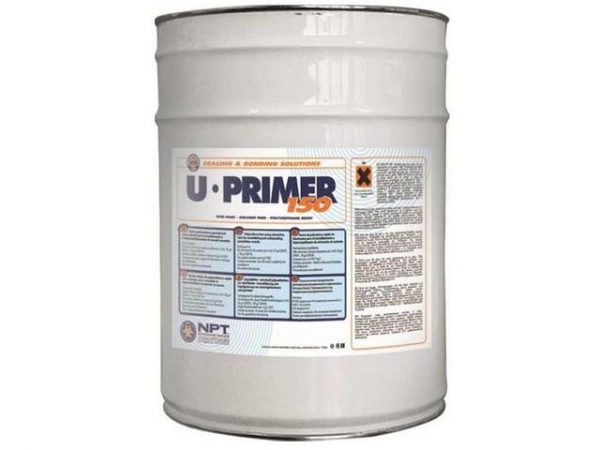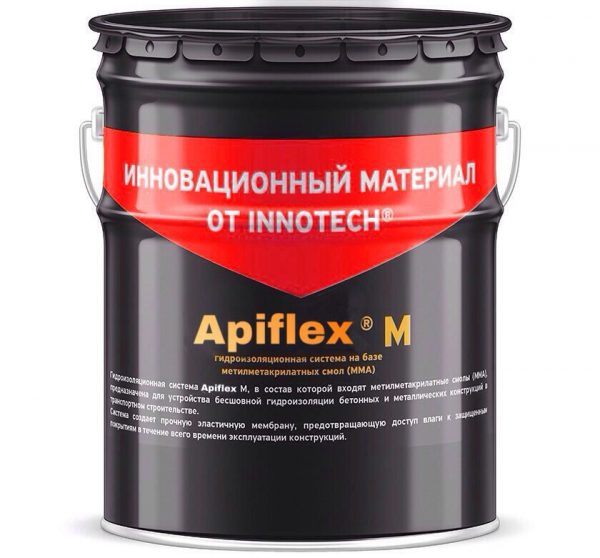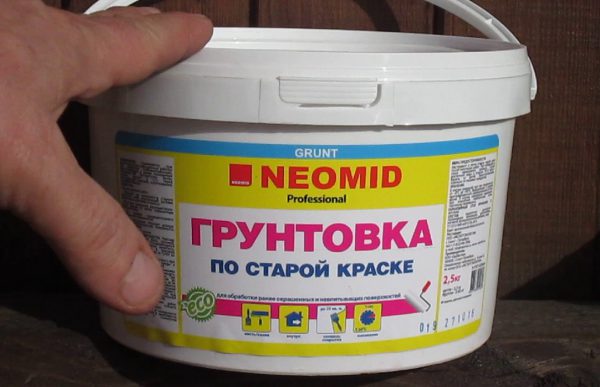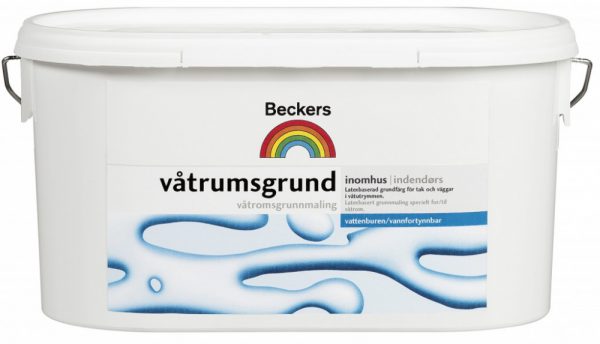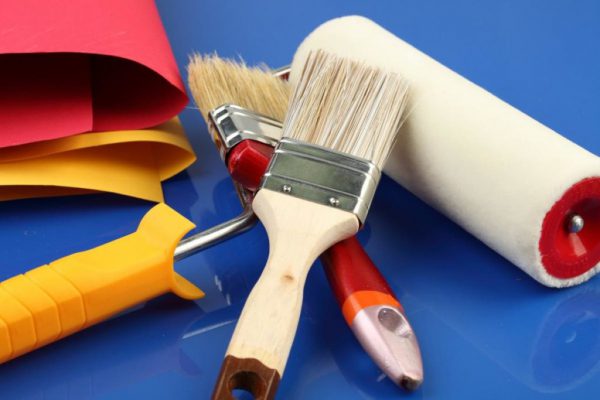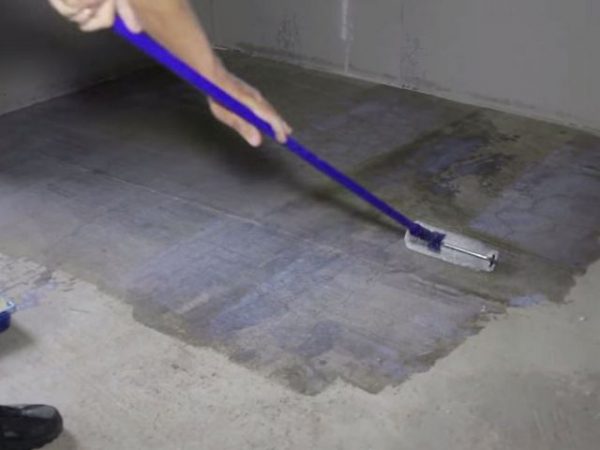Bulk floors are becoming more popular. This material is widely used in various types of premises - from industrial to residential. The technology for pouring floors is quite complicated, and without an accurate knowledge of the process it is easy to make a mistake. Primer for bulk floors - the most important component in the arrangement of the coating. Only a properly primed screed will serve faithfully for many years.
- The need for a primer
- Filling a floor without a primer: consequences
- Using a deep penetration primer
- Types of primers
- Universal soil
- Reinforcing soils
- Adhesive primers
- Multi soil
- Compositions of polymer primers
- Epoxy primers
- Polyurethane Primers
- Acrylic and latex primers
- Methyl Methacrylate Primers
- Primer selection
- Base type
- Type of premises
- Cost
- Ease of use
- Priming technology
- Primer Tools
- Surface preparation and priming
- Popular primer manufacturers
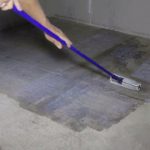
The need for a primer
Builders understand a bulk floor as a special coating with high strength and decorative characteristics. It is created by applying (pouring) a special polymer composition after surface preparation. The basis of the solution is cement powder, among the components are:
- modifiers
- fixers;
- plasticizers;
- polymer additives.
The latter allows the material after drying to become elastic, well-leveling, durable. Bulk coatings make it possible to create a perfectly flat floor, which can be decorated with any pattern or give a uniform color.
The manufacturer of any bulk floor gives an indication in the instructions that the rough screed before work must be carefully prepared:
- Remove all old flooring materials, including loose varnish and paint.
- Clean the base of oil, grease, soot, dirt, dust, soot.
- Wash the floor.
- Apply a primer.
Whatever the screed in thickness (from 1 to 100 mm), you can not do without a primer. This material will make a really high-quality coating with a long service life. Soil seriously improves adhesion of a new layer and a rough basis.
The main advantages of using a primer:
- Reduced moisture absorption. Any rough floor, even concrete, has a significant minus - it has a high ability to absorb water, pulling it out of mixes for pouring and leveling. Having absorbed water, the base wears out faster, mold and fungus can start in it. The metal rusts. If the subfloor is primed, the density of its upper layer increases, because the soils have saturating and moisture-insulating properties.
- Reliable adhesion of materials. A correctly selected soil helps to reduce the production of bubbles, the appearance of cracks, scratches, voids. Even quick drying of the grout will not lead to such problems, because the adhesion quality will be at a high level.
- Uniform distribution. A liquid solution poured onto a rough floor should ideally immediately spread out over the surface in an even layer. Pre-priming helps to increase the spreadability and make the floor smooth.
Soil creates optimal floor strength, allows to increase its elasticity, closes the smallest pores, prevents the appearance of fungus and improves the performance of the material. All manufacturers of bulk floors produce primers suitable for them. It is best to use products of the same brand that combine perfectly.
to contents ↑Filling a floor without a primer: consequences
The wizard will immediately give a definite answer to the question of whether a primer is needed before filling the floor. The use of soil is a mandatory stage of work. The material acts as a guarantor of comfortable and long-term operation of the base, helps to strengthen it.
to contents ↑Without applying the product, the new floor can begin to deteriorate after 1 - 2 years: cracks and bumps will appear on the surface. It is especially important to use a primer with high humidity in the room, otherwise the mineral substrates will be saturated with moisture, which will inevitably destroy the floor.
Using a deep penetration primer
This type of soil must be selected if the room has a special microclimate. For example, a deep penetration agent will be required for frequent changes in temperature in the sauna, with high humidity in the bathroom, shower, pool. Since the floor is constantly in contact with water, it is important that the soil penetrates into the deeper layers of the rough coating and creates a waterproofing layer.
to contents ↑Types of primers
All types of existing primers are divided into dry and liquid. The former must be diluted with water before use, the latter are ready and can be used immediately.
The composition of the material may be as follows:
- Mineral (cement). It is usually used for primary flooring, if there are significant irregularities. Such primers are well suited for concrete, plastered floors, expanded clay, aerated concrete.
- Alkyd. Masters use such primers on wooden, tile, fiberglass, plastic, metal substrates. Alkyd primers cannot be used on gypsum and plastered surfaces.
- Acrylic Perfect for plaster, wood as a top coat before pouring.
In addition to this classification, all primers can be divided according to their properties into universal, strengthening, adhesive, multifunctional.
to contents ↑Universal soil
Tools are based on water, solvents, solvent. Designed for quality foundation preparation and subsequent finishing. Primers have different positive properties, and therefore are considered universal. The compositions reduce absorption, strengthen, harden, optimize adhesion, but weaker in each individual quality than specialized ones.
to contents ↑Those primers that are made on the basis of water are safe for people, easy to apply, almost odorless. If the composition contains organic solvents, the material is completely toxic until dry, ignites quickly, and smells unpleasant. It is undesirable to use such soils in a residential building: they are more suitable for unheated buildings.
Reinforcing soils
Designed to increase the strength of the base, eliminate pores, which in the future will not allow to absorb moisture. For example, deep penetration primers without reducing the level of vapor permeability of the subfloor significantly reduce moisture absorption, penetrating by 1 - 5 cm depending on the brand, and reliably protecting the floor from water.
The composition contains polymers, polyurethane and acrylates, various additives and additives. On reinforcing soils, there is always a mark “For loose (weak) substrates”. Most often, coloring pigments are added to such primers, so that when applied it is easy to distinguish the untreated surface.Fastening primers drying fast - 0.5 - 2 hours.
to contents ↑Adhesive primers
These are the most popular concrete contacts among builders. Such primers are produced by all plants involved in the production of building mixtures, paints. The composition contains pigments, modifiers, quartz sand, polyurethane resins.
Thanks to the mineral filler (sand), the liquid solution after drying takes on a certain roughness, and the primer adheres perfectly to the subfloor. Adhesive primers can be used on most types of floors, except for highly absorbent ones.
to contents ↑Multi soil
They produce only certain brands, so finding them on sale can be difficult. Primer properties are unique. They can be applied on mineral and bitumen floors, bases with glue, putty, paint residues, floors made of stone, gypsum, ceramics, wood, iron, etc.
The composition includes a variety of resins and polymers (alkyd, polystyrene, glyphthalic and others). It is difficult to work with such soils, therefore they are mainly used by professionals.
to contents ↑Compositions of polymer primers
Soil selection should be carried out depending on the need and on the material that will be used for pouring.
Epoxy primers
Suitable for concrete, a mixture of concrete and asphalt, for wood. Epoxy primers are considered ideal for strengthening concrete screeds, increasing its service life.
Due to the nature of curing, all epoxy primers are available in two-component form - the basic composition and hardener in different containers. Those primers that are used for deep impregnation have a low viscosity. Thick solutions are used for additional patching of defects, cavities, preliminary alignment of the base. A good option would be to combine epoxy primers and epoxy bulk floors.
to contents ↑Polyurethane Primers
Great for applying under polyurethane bulk floors. They can be combined with different types of substrates - with concrete, cement-sand screed, metal, wood and even ceramic tiles.
If the strength of concrete is low, the coating is old, it is better to replace polyurethane primers with epoxy - the latter will be more effective. To reduce the cost of work, you can perform the first layer with an epoxy primer, the second - polyurethane.
to contents ↑Acrylic and latex primers
Such preparations are best suited for preparing wood and gypsum screeds for pouring the floor. By the ability to harden concrete, acrylic and latex in the form of primers are inferior to polyurethane and epoxy resins. For filling cracks, defects in concrete substrates, they are not suitable.
Methyl Methacrylate Primers
Dry very quickly and completely harden. High rates of adhesion and hiding power, although in terms of depth of penetration into concrete, these compounds are worse than epoxy and polyurethane agents.
Due to the relatively high cost, methyl methacrylate primers are used mainly for emergency repairs of premises, repair of certain sections of the floor.
to contents ↑Primer selection
The purchase of a primer should be done deliberately so that the material is suitable for the main parameters - the type of base and the type of room in which it is supposed to fill the floor.
Base type
Usually on the ground it is indicated for what basis the composition is suitable: for wood, iron, concrete, etc. There are universal primers that can be used on almost any type of subfloor. Any soil can be applied to the most common concrete substrates, but acrylic and latex mixtures are less preferred (adhesion will be worse).
If the cement screed contains alkali, fire-fighting additives, it is necessary to buy anti-alkaline primers.
When the subfloor does not need to be leveled anymore, but it is possible to fill immediately, they select the soils marked “finish”.
Only deep penetration primers are applied to painted floors, others will not work. The same tools are recommended for the repair of old screeds, since they significantly strengthen them and prevent the exit of dust.
Tiled bases are primed with polyurethane or epoxy primers.
to contents ↑Type of premises
It is very important to use special products in rooms with high humidity, especially where water is constantly present. Deep penetration soils will provide a reliable waterproofing layer.
In the wettest rooms it is recommended to perform priming with "liquid glass". In ordinary rooms, it is worth using primers such as concrete contact or products with anti-mold additives (biocidal primers).
to contents ↑Cost
Too cheap funds can be of poor quality, so you should not focus on the low price. The total cost of the work will depend on the primer consumption on the bulk floor. Consumption is due to the chemical composition of the material, the porosity of the surface.
to contents ↑Typically, 250 to 500 g / sq. Are consumed for the first layer. m of epoxy and polyurethane soils, 250 - 300 - acrylic, latex. Repeated layers consume 100-200 g / sq. m materials. Based on these figures, you can calculate the total cost of the primer.
Ease of use
Masters know how to work with any type of primer. This criterion is important only for someone who is trying to do all the work with his own hands. The easiest way to apply latex and acrylic primers, it is quite difficult to work with epoxy.
Priming technology
Priming the floor in the room is necessary in compliance with certain rules and requirements, otherwise the quality of adhesion to the surface will seriously decrease.
Primer Tools
To perform the work, you can use any convenient tool. For small rooms, they usually buy brushes (mowls) and comfortable rollers with a small pile. Large floors are recommended to be primed with a spray gun.
to contents ↑Surface preparation and priming
Before starting repairs, the base should be well prepared. It is advisable to completely remove the old coating, especially its exfoliated parts, until a sufficiently strong base remains. Remove all debris and dust from the screed - even the smallest particles of foreign substances will cause the appearance of bubbles on the bulk floor. After manual cleaning or vacuuming, the floor must be washed. In the presence of deep defects, pits use self-leveling screeds. After the seams are smoothed, sanded.
Immediately before applying the primer, make sure that the substrate is completely dry. A piece of polyethylene is placed on the floor and left for 24 hours. If during this period moisture collects under it, the surface is wet, further drying is required. For this, the room is left for another 2 to 3 days.
All corners and joints can be sealed with sealant to eliminate bumps during the filling process. If the walls are already finished, it is advisable to paste them with masking tape on the bottom. In case of thermal expansion of the coating along the walls, a damper tape is glued.
Priming process:
- The mixture for application is carefully prepared. Dry materials are bred according to the instructions, ready-mixed - well.
- Soil application begins. First, it is applied in a uniform layer from the far corner (relative to the door), after which the solution is distributed over the entire base.
- The finished layer is dried for at least the period indicated on the package. This time depends on the type of primer.
- Repeated layers are applied according to need.Where the material is very porous, drying takes place quickly, and therefore more primer layers are required.
- Complete drying time depends on the type of soil. It is not recommended to start filling the floor earlier than after 2 days. The surface should be completely dry, not sticky.
Popular primer manufacturers
The most demanded by the masters for the repair of premises and filling the floor with soils of such grades:
- Bergauf;
- Ceresit;
- Knauf.
The quality of these products is at a high level, it is only important to choose the right primer in each case and strictly observe the application technology.

